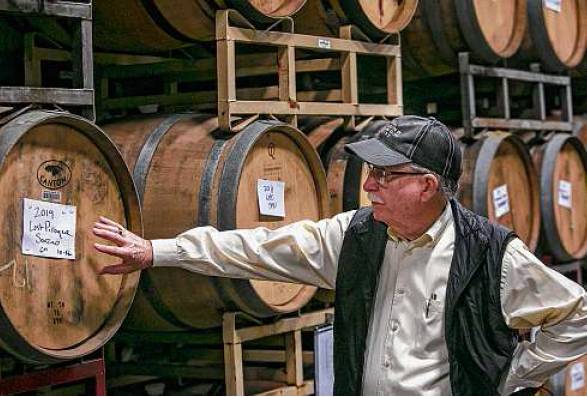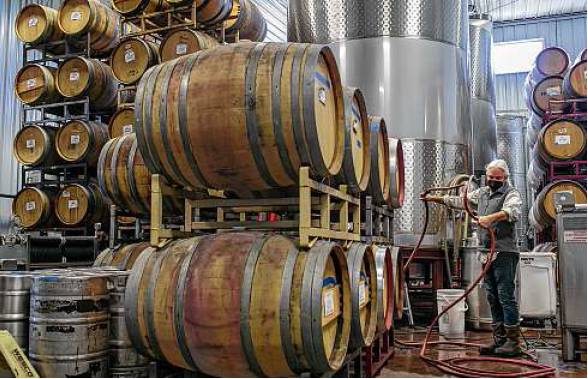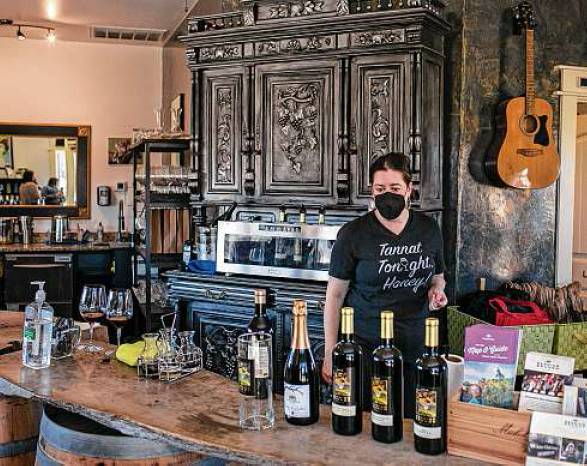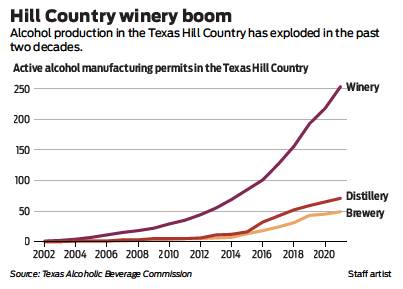In the Hill Country, it’s always wine o’clock
Alcohol makers, tourists flocking to the region
By Annie Blanks STAFF WRITER
TEXAS HILL COUNTRY — It’s a breezy, sunny Friday in Comfort, population 3,717.
The grapevines at Bending Branch Winery near the lazy Bruins Creek have dried up in the cold January air, and winery technician Melvin Mendez is still out pruning them, getting ready for the July-through-October harvest season.
Despite the chill in the air, at noon the tasting room is expecting visitors. They’ll come to try the winery’s signature Estate Tannat red wine as they sit on the outdoor, shaded patio overlooking the rolling hills that gave the Hill Country its name.
From that vantage point, it’s not hard to imagine why Bending Branch — along with hundreds of other wineries, breweries and distilleries — came to call the Hill Country home over the past two decades.
“We’re one of the fastest-growing winery tourism regions in the country,” says Jennifer McInnis, the general manager of Bending Branch Winery. “I think people come here for soil and elevation, but also just the fact that there are already wineries here and the whole Hill Country wine region between San Antonio and Austin means there are millions of people nearby.”
In fact, over the past decade, the winery, brewery and distillery industry in the 25 counties that make up the Hill Country has seen explosive growth.
According to the Texas Alcoholic Beverage Commission, the state agency that regulates the Texas alcohol industry, 35 winery permits were active in the Hill Country in December 2011. Ten years later, in December 2021, there were 254. That’s an increase of 625 percent.
And although wineries are the most popular type of alcohol producer in the Hill Country by far, permits for breweries and distilleries also have seen sharp increases, according to TABC data.
In December 2011, there were five active distillery permits in the 25 Hill Country counties, compared with 71 in December 2021 — more than a thirteenfold increase. The number of active brewer permits grew from five to 49 over the same period — a nearly ninefold increase.
So, why the sudden and sharp growth?
It partly has to do with elevation, soil and views, of course. But there’s also a solid “if you build it, they will come” mentality in the Hill Country, said January Weise, the executive director of Texas Hill County Wineries, a nonprofit trade association that organizes and promotes the region’s wineries.
“The notoriety is here. The opportunity is here. The wine infrastructure is here,” Weise said. “It’s great to have a large group of wineries in a single area because that draws people in.”
The wine economy
The Hill Country’s characteristic rolling terrain, wide open spaces and ample land for planting, growing and producing all types of alcohol, as well as its abundant population growth and economic incentives, have helped draw companies.
A 2017 study from Texas Tech University found that the Texas wine industry had a $13.1 billion economic impact, and the Hill Country saw about 1.7 million tourists each year. No comprehensive industry studies have been done looking at the Hill Country in particular since then, but anecdotally, Weise said, the growth and impact have been astronomical.
“There are more wineries, more guests, more visitors. Everyone’s telling their friends and neighbors about this area,” she said. “Wineries are entering competitions and gaining notoriety. The industry and the nation are taking notice of the Texas Hill Country, and that’s having a huge, positive impact.”
Economically and population-wise, the Hill Country shows no sign of slowing down, and wine country tourism is expected to continue to rise in the coming years.
“The wineries have provided more jobs and opportunities for Hays County residents, especially in the bigger areas,” Weise said. “In places like Dripping Springs, you can’t drive a mile without seeing a sign for another brewery or distillery.”
Out-of-state business
The Hill Country’s wine scene is becoming so popular that it’s drawing not just local, Texas-bred winemakers but out-of-state enthusiasts and businesspeople as well.
Sarah and Brice Garrett call themselves “millennial winemakers.” They got their start in Paso Robles, Calif., in 2015. Their winery, Serrano Wine, quickly took off in the California wine scene, attracting a younger generation of wine enthusiasts and building a healthy brand in the country’s most famous wine region.
But in 2021, the couple decided they wanted to move their operation to a region that had more room for growth. After a search that included properties in New York, Washington state and Oregon, the Garretts found their patch of dream land in Hye, a small, unincorporated community in western Blanco County.
“We saw this region as brimming with opportunity, and I think it can surpass Napa as the most visited wine region in the country,” Sarah Garrett said. “We thought, ‘This is a place that can grow, just like us.’ ”
A big selling point for the Garretts was how business-friendly Texas’ laws are compared to California’s.
The advantage is welcome, given that “we don’t have Texas oil money or California tech money; we don’t even have employees,” she said. “We’re really doing this all on our own.”
The Garretts moved to the 10-acre Hye property in late 2021. They’re building a full winery and tasting room, as well as planting 4 acres of vines.
They’ve spent their first few months as Texas residents visiting other wineries and building a rapport with fellow winemakers.
Weise said the more wineries that come to the Hill Country, the better.
“Usually you don’t want competitors right down the street, but in this case it can really benefit these businesses, because it makes the entire region a destination,” she said.
Grape-growing
The region’s hilly terrain makes it ideal for grape-growing, and Serrano Wine will be one of a handful of Hill Country wineries to grow their own grapes. About 80 percent of the region’s winemaking grapes currently come from the Texas High Plains region, which has 8,000 acres in production.
While the Hill Country encompasses about 9 million total acres, not all that land is amenable to grape growing. But on land that is suitable, more acres are devoted to grape growing. While the region had about 450 acres of vines 10 years ago, it has about 1,500 acres now.
Because the Hill Country region is so vast, there’s real diversity in the types of grapes it can grow, as different varietals grow well in different areas.
“The soil and climate isn’t going to be the same across the entire Hill Country region,” Weise said. “The man who owns Driftwood Estates Winery (in Driftwood) says that chardonnay does fantastic at his place, but over near Johnson City, they say chardonnay doesn’t grow well over there.”
Bending Branch’s 56-acre property slopes north to south and is ideal for grape-growing and wine-making, though it also sources grapes from California, where it has a sister vineyard, and from the High Plains. The winery produces about 25,000 cases of wine each year; that comes out to 1.5 million glasses, in case you don’t drink wine by the case.
“The elevation is higher here, the drainage is good, and the soil is good for growing grapes,” said Bob Young, the owner of Bending Branch. “Plus, it’s beautiful.”
Annie Blanks writes for the Express-News through Report for America, a national service program that places journalists in local newsrooms. ReportforAmerica.org. annie.blanks@ express-news.net.





